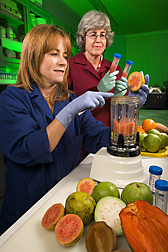|
Read the
magazine
story to find out more. |
|

Technician Holly
Sisson (left) and horticulturist Elizabeth Baldwin homogenize guava for
antioxidant and pigment analyses. Click the image for more information about
it.
|
|

|
U.S.-Thai Scientific Efforts Peg Guava's
Nutritional Value
By
Alfredo Flores
October 1, 2007
A cooperative study by Agricultural Research Service (ARS) and Thai scientists has shown that
guava fruit is high in antioxidants—adding it to the list of other
antioxidant-rich foods such as blueberries, black beans and broccoli.
Because tropical fruits aren't usually grown in cooler U.S. climates,
little information about their nutritional value—especially of that of the
more "exotic" species—has been developed. But South Florida growers are
beginning to produce guava, carambola, pitaya, mamey sapote, sapodilla, lychee,
longan, mango and papaya to meet rising consumer demand for unusual fruits.
At the ARS
U.S.
Citrus and Subtropical Products Research Laboratory in Winter Haven, Fla.,
scientists have been using standard methods to analyze tropical fruits from
South Florida for components that could be beneficial to human health.
Leading the research is ARS horticulturist
Elizabeth
Baldwin, with ARS chemists
John
Manthey and
Kevin
Goodner, along with cooperating scientists at the
University of Florida's Citrus Research and
Education Center in Lake Alfred, and at Siam University-Bangkok and
Chiang Mai University, both in
Thailand. The Thai researchers are testing Southeast Asian variations that are
not native to Florida. The Tropical Fruit Growers of South
Florida provided a grant to make the research possible.
Fruits and vegetables play a significant role in the human diet
because they provide an optimal mix of antioxidants such as vitamins C and E,
polyphenols, carotenoids and complex carbohydrates. Antioxidants are plant
chemicals that have the power to neutralize free radicals, toxic compounds
generated inside the human body and also found in pollutants like cigarette
smoke. Getting rid of these damaging compounds can help improve human health,
since free radicals cause oxidative damage to human cells that can trigger
various chronic diseases.
In the study, guava's antioxidant content ranked just below that of
blueberries, which is No. 1 in antioxidant activity. Other fruits ranking
surprisingly high were carambola, lychee, mango and papaya.
Read more
about these studies in the October 2007 issue of Agricultural
Research magazine.
ARS is the U.S. Department of
Agriculture's chief scientific research agency.